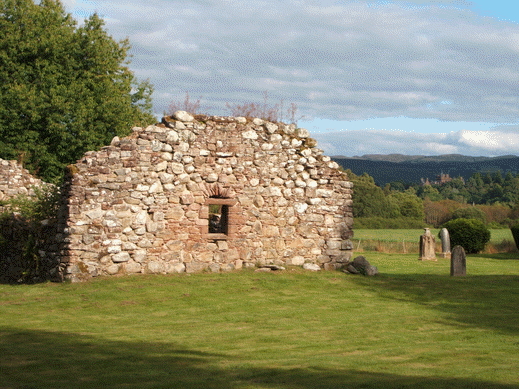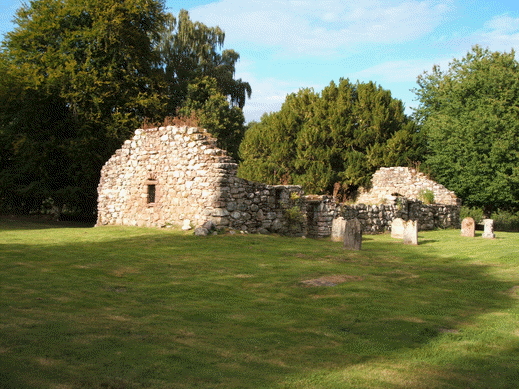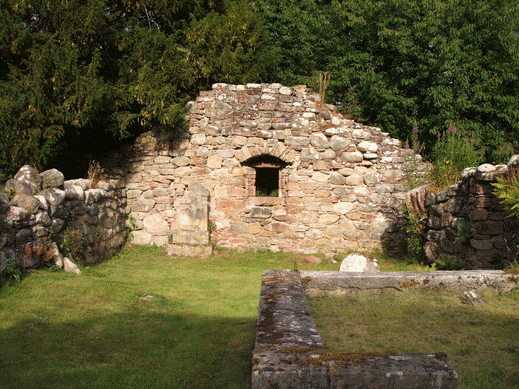Inverness Deanery
Kiltarlity
(Cill Taraghlain)
Parish Church: OS Ref: NGR NH 498439 H.E.S. No: NH44SE 1 Dedication: St Talorcán
Associated Chapels: Beauly Castle {NGR NH 507430}.
In the written record, this parish is also caled Kyntallirgy, Kintallirgy, Kyltalargyn, Lovat Church and Tallarice. "The church stands on the bank of the river a mile above the lower end of the parish. Kelmorack(sic) Church stands a furlong away on the opposite bank. The parish stretcheth on the east side of the river Farrar (Varrar, sometimes known as "the monks' river"), and is about 14 miles in length. This river divides Kiltarlity from Kilmorack {which is in the diocese of Ross} and a range of hills runs between Kiltarlity and Urquhart and Glenmoriston parishes."1
Kiltarlity was founded by John Bisset out of the parish of Conveth, which, before, included all that ever belonged to Kiltarlity. The new parish of Kintarlity included Erchless, a davoch-estate in the earldom and diocese of Ross2, for long the seat of the Chisholm. Conveth (Convinth) was a huge parish geographically and it seems reasonable to suppose that, even in the early days, before the creation of the new parish, there was a chapel at Kiltarlity to serve the people dwelling in the area towards the Aird. If this was the case then perhaps we have the source of the dedication to St Talorcán, who is supposed to have been a sixth-century Pictish saint who operated as a 'wandering bishop' (episcopus vagans) in Banffshire and Aberdeenshire.3
There is good reason to believe that this new parish was originally considered to be in the diocese of Ross, since, in early 1226, it was from the Bishop of Ross that John Byseth received the patronage of the church in exchange for any rights which John had in the churchlands of the parish. John also gave to the bishop and chapter of Ross, 15 marks towards the fabric of the cathedral at Rosemarkie, and one stone of wax annually for the lighting of the altar.4
Later that year, John Byseth granted Kiltarlity to the newly founded hospital of Rathven.5 This seems a strange thing for Byseth to do, especially since Rathven is so far from his lands. But another member of his family, Robert Byset of Upsetlington, possessed a Hospital of St Leonard (a lepper hospital) at Horndean, in the territory of Upsetlington, which, in 1240, he gifted to Kelso Abbey.6 The similarity - a Hospital beside a parish church - is marked. The parsonage of Kiltarlity, thereafter, remained annexed to Rathven.
Very soon, however, the whole question of 'rights' over the church of Kiltarlity became a seriously debated issue between the bishops of Ross (Robert I) and Moray (Andrew de Moravia). Eventually, an agreement (composito) was reached: Robert resigned all of his rights in the church of Gylltalargyn (Kiltarlity) and, in return, Andrew resigned his rights to the church of Ardeseir (Ardersier). Robert also agreed to pay the 'unam petram cerre' (annually), which John Byseth had gifted to the cathedral of Ross, to the bishop of Moray. Both parties agreed that if either of them should fail to uphold this agreement they should forfeit £100 sterling to the other party.7
The ruins of the 'old parish church' of Kiltarlity are those of the post-Reformation building dated to 1628. However, it is considered that these ruins stand on those of an earlier, medieval, chapel.
Near to the ruins of the old parish church is Beaufort Castle, which, in earlier times, was known as Castle Downie (Dounie), and was a seat of the Byseth family from the time of King Alexander I (1106-1124). In the 13th-century it passed to the Fraser Lords of Lovat.


Above: Views of Old Kiltarlity Church and Churchyard.

Above: Interior of Kiltalrity looking east.
In 1766, the church, manse and glebe, were transferred to Tom-na-Crois
A fair of St Muireach (Murdoch) was held at Kiltarlity.17
| Name | OS Grid Ref. | Extent | Comment |
|---|---|---|---|
| Erchless | NH 41_41_ | 1 dabhach | In diocese of Ross. |
| Fothenes | NH 524428 | 1 dabhach | now Phioneas. |
| Dunyn | NH 507430 | 1 dabhach | now Dounie, where stands Beaufort Castle. |
| Muy (A) | (unidentified) | 1 dabhach | now Ardrannich? |
| Muy (B) | NH 55_52_ | 1 dabhach | now Clunes? |
| Kiltarlity | NH 498439 | ½ dabhach | The 'church lands' which included the fishing. | Reg. Ep. Mor., no.21, p.15; with OS Refs added by David de Moravia |
Ross suggests that Kiltarlity, "must always have been a very small parish of four dabhaichean."8 However, in his lists, he then includes five dabhaichean that would appear to have been in Kiltarlity parish, to add to the half-dabhach of the 'church lands'.
1203-24 An agreement is recorded whereby John Byset quitclaims the advowson of the church of Dalbatelauch (Dunballoch) with its nine dabhaichean (Dunballoch; Fyngasc; Moreweyn; Lusnacorn; Munythoc and altera Munythoc; "et tribus dauchis de Ferge"). In return, the bishop (Bricius de Douglas) grants to John Byset the advowson of the church of Coneway (Convinth) containing ten dabhaichean - Gulachkyn (Guisachan); Buntach (Buntait); Herkele (Erchless); Cumber (Comerkirktown); Coneway (silicet 2 dauachis - E and W Conveth); Brutach Muy; Altera Muy; Dunyn (Downie); Fothenes (Phoineas).9
c.1226 John Bisset gave to Beauly Priory the multures of several lands in Kiltarlity and, most valued of all, the salmon fishing on the Forne, the old name for the lower reaches of the River Beauly.10
1253-80 Bishop Archibald reaches an agreement with Sir David Graham,11 lord of Lovat, settling a dispute concerning the fishing rights at the Esse on the river Forn (lower Beauly). Sir David quitclaims his rights to these fishings, in pure and perpetual alms. In return, the bishop hands over in feuferme (rents) all his land of the church of Kiltarlity, with all its pertinents and fisheries, including both that land which Sir David had just quitclaimed to the bishop, as well as that land which the bishop had acquired from Sir William de Fenton, lord of Baikie and Beaufort. Sir David is to hold these possessions at feuferme for 100s. annually, paying half at the Assumption of the B.V.M. and the other half at the Purification of the B.V.M.12
The fishings at 'the Esse' were some of the best on the river and so were of great value to whoever controlled them. There were a series of cruivies (wicker salmon traps) just downstream of the Esse.
1280 (Tuesday, 26 March) Robert, bishop of Ross, the dean of the church of Ross and the prior of Beauly, deputy executors of the Abbot of Deer, sole judge-delegate in the dispute between Bishop Archibald of Moray and Sir William of Fenton, lord of Beaufort in the Aird and Cecilia his spouse, write to the dean of christianty of Inverness, the rector of Lundechty (Dunlichity) and the vicar of Wardlaw, informing them that the bishop, the dean and the prior had personally placed Bishop Archibald of Moray in corporeal possession of the church of Kiltarlity on 27 Sept. 1279, and, with apostolic authority, publicly denounced anyone who might presume to impede the bishop taking up possession.
The dean, rector and vicar are directed to travel with their chaplains to Beaufort Castle and threaten Sir William and Cecilia with excommunication and ecclesiastical interdict.13
1280 (Sunday, 18 August) Bishop Archibald issues a charter at Spynie addressed to all the clergy convened in council at the Black Friars in Perth, requesteing that the church council carry out sentence of excommunication against Sir William de Fenton. It would seem that the noble lord was still in dispute with the bishop.14
Other Churches and Chapels in the parish.
Beaufort Castle. There was a chapel of St Lawrence at the east end of Beaufort Castle, in Kiltarlity parish, seat of the Frasers of Lovat. All that was left of it in the second half of the seventeenth-century was "the east window closed up in time of warre."15 This chapel would appear to have been for private use and to have been without endowment or parochial jurisdiction.
Beaufort Castle was entirely demolished after the Battle of Culloden since the Frasers of Lovat were staunch Jacobites.
Parish Clergy:
c.1315 Henry, chaplain of Beaufort (Castle), witnesses a charter of Celia Byset. [Beauly Charters, no. 8] By this charter, Celia Byset, widow of Sir William de Fenton, lord of Baikie and Beaufort, grants, in her widowhood, for the salvation of her soul and the soul of her ancestors and successors, to God and the Blessed Mary, and the Blessed John Baptist, and the brethren of the Valliscaulians serving and to serve God in the House of Beauly, all the third part of the land of Altyr
1. Shaw, L (1882) The History of the Province of Moray, Glasgow, vol. 2, p.377-378.
2. The earldom and the diocese were co-extensive.
3. Mackinlay, J M (1914) Ancient Church Dedications in Scotland: Non-Scriptural Dedications, Edinburgh, p.176. The church of Fordyce in the deanery of Boyne, Aberdeen diocese, is supposed by some to be dedicated St Talorcán (Talarican or Talorgan).
4. Reg. Moray, 258.
5. Reg. Moray, 71, 72.
6. Kelso Liber, i, no.240.
7. Reg. Moray, 75. Signed at Kenedor (Kinneddar) on the Feast of the Vigil of the Purification of the B.V.M. (2 February), 1226-1227.
8. Ross, A (2003) The Province of Moray, c.1000-1230. PhD Thesis submitted to the University of Aberdee, 2003. Vol.1, 88.
9. Reg. Moray, 21, given at Spynie Church.
10. 3rd Statistical Account, 222.
11. Sir David de Graham married Muriel, one of the three co-heirs of Sir John Byset (†1259), and so came into possession of Beaufort.
12. Reg. Moray, 123, 124.
13. Reg. Moray, 127a.
14. Reg. Moray, 127.
15. Mackinlay, J M (1914) Ancient Church Dedications in Scotland: Non-Scriptural Dedications, Edinburgh, p.396.
16. Batten, E C (1877) The Charters of the Priory of Beauly, London: for the Grampian Club. p.75-77.
17. Scott, H (1915-61) Fasti Ecclesiæ Scoticanæ, Edinburgh, vol.vi, p.468. https://archive.org/details/fastiecclesiaesc06scot/page/468
e-mail: admin@cushnieent.com
© 2019 Cushnie Enterprises
